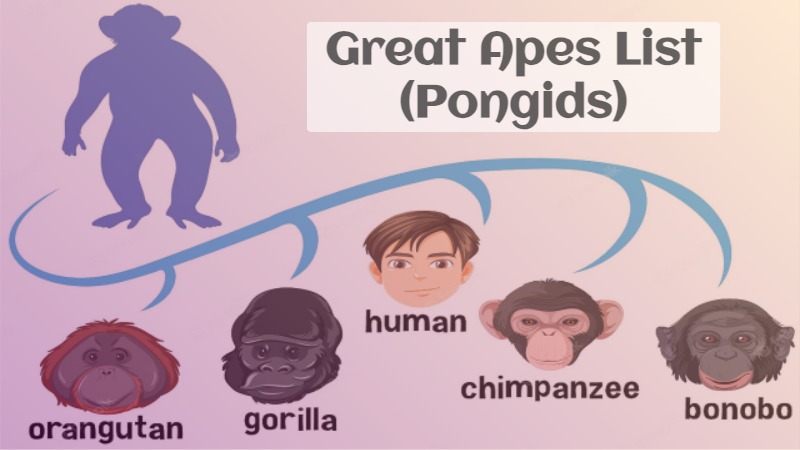
Great apes list with common names & scientific names of pongids, check description of species and taxonomy of pongidae family. In the classification of living things, Pongidae is the family of animals that are our closest relatives in the animal kingdom. The members of that family, which are called Pongids, are the gorillas, chimpanzees, bonobos and the orangutans. An often-used illustration of how closely related we are is the fact that our DNA is so similar (there is only a 2.5% difference in the nucleotide sequence in the DNA of humans and chimps, compared to a 15.8% difference between humans and the new world monkeys, for example).
The pongids are sometimes referred to as the ‘great apes’ (more because of their size than their accomplishments). The pongids do not have tails, and they are both larger and more intelligent than the gibbons and simangs (family Hylobatidae) and the monkeys. They generally have complex social habits, although the orangutans tend to be rather solitary, territorial creatures who hang about in the trees a lot.
The chimps and gorillas spend most of their time on the ground. They move around mostly on their legs, but touching their hands to the ground to keep balance. (They are sometimes called ‘knuckle-walkers’ for that reason.) Their skeletons are not well-designed for full-time upright walking. The bonobo chimps are known for their particularly licentious sexual behavior, as well as their exceptional intelligence.
Great Apes List
| Common Names of Pongids | Scientific Name |
|---|---|
| Gorillas | Gorilla gorilla |
| The common chimpanzees | Pan troglodytes |
| The bonobos | Pan paniscus |
| The orangutans | Pongo pygmaeus |
***Pongids are the great apes belonging to the Pongidae Family.
Brief Description of The Great Apes Species
The Pongidae family, also known as the great apes, is a taxonomic family that includes four extant species: orangutans, gorillas, chimpanzees, and bonobos. These species are considered the closest living relatives of humans, sharing a common ancestor with us. Here’s a brief description of each species:-
- Orangutans: Orangutans are large, primarily arboreal apes native to the rainforests of Borneo and Sumatra. They have long arms and reddish-brown hair. Orangutans are known for their high level of intelligence, tool use, and solitary lifestyle.
- Gorillas: Gorillas are the largest living primates and are found in the forests of central and eastern Africa. They have a robust build and live in social groups called troops. Gorillas are herbivorous and have a peaceful nature, primarily eating plants and fruits.
- Chimpanzees: Chimpanzees inhabit the forests and woodlands of central and western Africa. They are highly intelligent and exhibit complex social behaviors. Chimpanzees are known for their tool use, communication skills, and close genetic similarity to humans.
- Bonobos: Bonobos are closely related to chimpanzees and are also found in the forests of central Africa. They share many traits with chimpanzees but are generally more slender and have longer limbs. Bonobos are known for their matriarchal social structure and their peaceful and cooperative behavior.
These great apes are highly endangered due to habitat loss, poaching, and other human-related factors. The study of these species is essential for understanding our own evolutionary history and promoting their conservation.
Distinction of Great Apes (formerly pongids) to Hominins
| Distinction | Great Apes (formerly pongids) | Humans |
|---|---|---|
| Mode of locomotion | Knuckle walking, arboreal | Bipedalism |
| Location of foramen magnum | Back of the skull | Under the skull |
| Skull (viewed from top) | pear-shaped | ovoid |
| Widest part of skull viewed from behind | Parietal region | Base of the skull(near the auditory region) |
| Palate | Rectangular | Parabolic |
| Body growth | Fast | Slow |
| Phalanges | Curved | Straight |
Taxonomy – Tree of Life
| Domain: | Eucarya | Living things whose cells have nuclei |
| Kingdom: | Animalia | The animals |
| Phylum: | Chordata | Animals that have backbones |
| Class: | Mammalia | Warm, furry, milk-producing animals |
| Order: | Primates | Lemurs, monkeys, apes, etc. |
| Suborder: | Anthropoidea | Simian primates (all the monkeys, apes, etc.) |
| Infraorder: | Catarrini | Old World monkeys, gibbons, apes |
| Superfamily: | Homonoidea | Great apes and humans |
| Family: | Pongidae | Great apes other than humans |
The Great Apes in Pongidae Family
The 1960s saw the methodologies of molecular biology applied to primate taxonomy. Goodman’s 1964 immunological study of serum proteins led to re-classifying the hominoids into three families: the humans in Hominidae; the great apes in Pongidae; and the “lesser apes” (gibbons) in Hylobatidae. However, this arrangement had two trichotomies: Pan, Gorilla, and Pongo of the “great apes” in Pongidae, and Hominidae, Pongidae, and Hylobatidae in Hominoidea. These presented a puzzle; scientists wanted to know which genus speciated first from the common hominoid ancestor.










